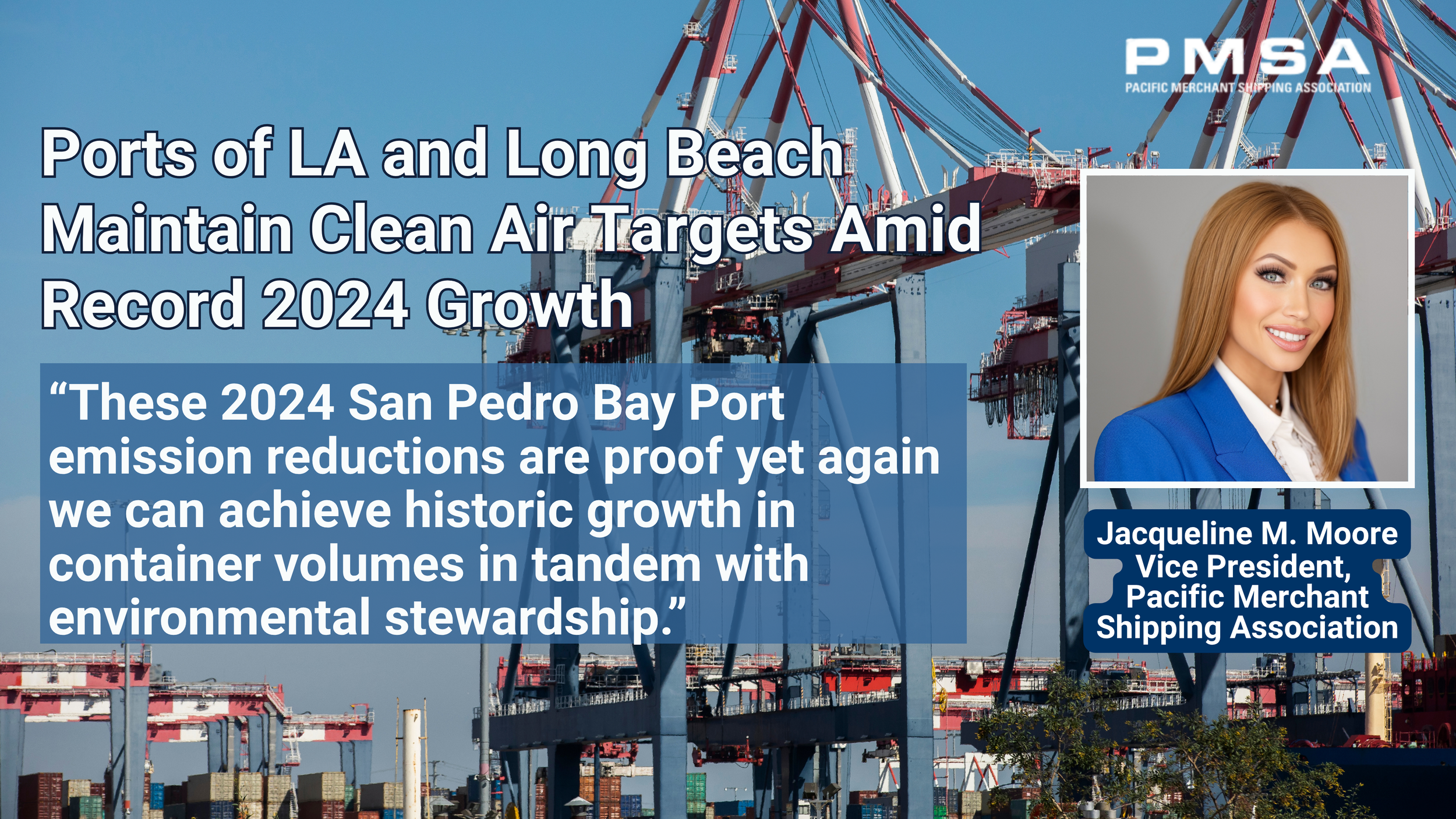
Search our collection of articles, blogs, resources and more to stay informed on the goods movement sector.
PMSA Statement on Approval of a Cooperative Agreement with the Ports of Los Angeles and Long Beach
LONG BEACH, CA – Mike Jacob, President of the Pacific Merchant Shipping Association (PMSA), issued the following statement following today’s South Coast Air Quality Management District (SCAQMD) Board meeting…
Port Indirect Source Rule Newsletter #16
Southern California’s business, labor, and community leaders are uniting behind the Ports of Los Angeles and Long Beach’s Cooperative Agreement with SCAQMD. This balanced, results-driven plan builds on decades of clean air progress and collaboration. Join us on November 7 to show your support for a cleaner, competitive future for our ports and communities.
Restoring Regional Cooperation: A Model for Clean-Air Governance in California
By Thomas Jelenić, Vice President, Pacific Merchant Shipping Association
This article explores the renewed collaboration between the ports, industry, labor and regulators in Southern California — proving that when stakeholders unite behind clear infrastructure and emissions frameworks, shared goals like decarbonization and cargo growth become achievable. Join us in supporting this balanced future.
Ports of LA and Long Beach Maintain Clean Air Targets Amid 2024 Growth
By Jacqueline M. Moore, Vice President, Pacific Merchant Shipping Association
In 2024, the San Pedro Bay port complex achieved historic cargo growth while sustaining ambitious air quality targets under the Clean Air Action Plan. Diesel particulate matter, nitrogen oxides, and sulfur oxides all remain far below 2005 baselines, even as throughput surges. Discover how ports can expand and decarbonize together.
WSC Launches Global Dual-Fuel Fleet Dashboard
The World Shipping Council has launched its Dual-Fuel Fleet Dashboard, which monitors the global liner fleet’s transition to renewable and lower-emission fuels. As of September 2025, more than 350 dual-fuel container ships and vehicle carriers are active, with orders accelerating toward a low-carbon future. Explore the trends shaping shipping decarbonization.
September 2025 Report on Containerized Trade at North American Seaports
In September 2025, the Ports of Los Angeles and Long Beach saw declines in container volumes year-over-year, but still posted gains compared to 2019. Other major U.S. and Canadian seaports showed divergent trends. Explore full port comparisons and regional performance in this latest analysis.
Impact of Higher Tariffs on Imported Kitchen Cabinets and Bathroom Vanities
In a new executive order, the U.S. imposed higher tariffs on imported kitchen cabinets and bathroom vanities, aiming to protect domestic industries. But these levies could also reduce container traffic through major gateways like the Ports of Los Angeles and Long Beach. Explore trade shifts, sourcing changes, and port impacts in this analysis by Natasha Villa.
U.S. Soybean Seaborne Exports
With China halting U.S. soybean imports, shipments to alternate buyers like Egypt, Germany, Indonesia, and Japan are rising—but not enough to fully compensate. Explore export trends, port flows, and market impacts in this deep dive
Diverting California’s Tree Nut Exports
California’s almond, walnut, and pistachio exporters are redirecting more cargo through Southern California ports and Houston, reducing Oakland’s historic share. Learn why logistics, rail links, and market dynamics are driving this shift in U.S. agricultural export flows.
August 2025 TEUs
In August 2025, the Ports of Los Angeles and Long Beach handled nearly 945,000 inbound loaded TEUs—down 2.2% year-over-year but up 24.3% vs. 2019. Get a full breakdown of U.S. port volumes, inbound/outbound trends, and YTD comparisons in our latest data release.
Emissions Reductions at Ports of LA, Long Beach Continue to Outperform Their Air Quality Goals Through 2024
Ports of Los Angeles & Long Beach have maintained emissions cuts in 2024—surpassing air quality goals for NOₓ, SOₓ, DPM, and GHG.
San Pedro Bay Ports Container Dwell Times for September 2025
In September 2025, San Pedro Bay ports maintained efficient operations with truck dwell times averaging 2.75 days and rail dwell times at 3.98 days.
PMSA Statement Regarding Air District Decision to Move Forward on Cooperative Alternative to Seaport Regulations
The Pacific Merchant Shipping Association (PMSA) applauds the South Coast Air Quality Management District (SCAQMD) for moving forward with a Cooperative Agreement alongside the Ports and Cities of Los Angeles and Long Beach. This collaborative approach replaces the previously proposed Indirect Source Rule (ISR), aiming for enhanced emissions reductions through voluntary, consensus-driven efforts. PMSA highlights the success of this model in achieving significant air quality improvements without resorting to burdensome regulations.
Clean Air, Quality Jobs, Affordable Goods: The Collaborative Path for Southern California’s Ports
By Paul Granillo, President & CEO, Inland Empire Economic Partnership
California ports lead in clean air progress. Learn how collaboration, not regulation, is driving zero-emission supply chains and economic strength.
Preliminary August 2025 TEUs
In August 2025, San Pedro Bay ports handled 944,832 inbound loaded TEUs, a 2.2% decrease from the previous year but a 24.3% increase from 2019.
Black Swans and Container Forecasts
By Jock O’Connell, Economist
Black swan events—unpredictable, high-impact disruptions such as strikes, cyberattacks, and maritime crises—are reshaping container shipping and global supply chains. Learn how ports, shippers, and logistics operators are adapting forecasts and strategies to build resilience against these rare but costly events.
Historic U.S. West Coast Container Traffic by Weights and Values
In July 2025, U.S. West Coast ports accounted for 37.2% of U.S. containerized import tonnage, with the Ports of Los Angeles and Long Beach capturing 28.8% of the share. This marks a slight year-over-year decline from 37.8% in July 2024. Notably, the LA/LB ports increased their share of containerized import tonnage from East Asia by 1.3 percentage points, reflecting their continued dominance in trans-Pacific trade.




















